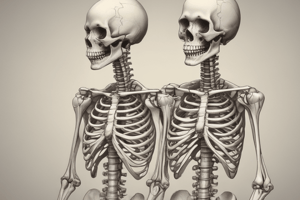Podcast
Questions and Answers
What is the primary function of the pelvis?
What is the primary function of the pelvis?
- To support the weight of the trunk and transport it onto the limbs (correct)
- To protect the organs in the thoracic cavity
- To facilitate movement of the limbs
- To aid in respiration
What is the name of the structure formed by the fusion of two hemipelvis and the sacrum?
What is the name of the structure formed by the fusion of two hemipelvis and the sacrum?
- Sacrum
- Pelvic girdle (correct)
- Innominate bone
- Pelvic cavity
What is the name of the muscle found on the iliac fossa?
What is the name of the muscle found on the iliac fossa?
- Tensor fasciae latae
- Iliacus (correct)
- Psoas major
- Gluteus maximus
What is the term for the angle used to identify gender anthropologically?
What is the term for the angle used to identify gender anthropologically?
At what age do the ilium, ischium, and pubis bones typically merge?
At what age do the ilium, ischium, and pubis bones typically merge?
What is the term for the four main categories of pelvic shape?
What is the term for the four main categories of pelvic shape?
Why do phenotypical females have thinner pelvic bones?
Why do phenotypical females have thinner pelvic bones?
What is the name of the ligament that joins the sacral bone to the rest of the pelvic girdle?
What is the name of the ligament that joins the sacral bone to the rest of the pelvic girdle?
Which of the following is NOT a type of pelvic fracture?
Which of the following is NOT a type of pelvic fracture?
Which joint is responsible for transferring weight from the spine to the pelvic ring?
Which joint is responsible for transferring weight from the spine to the pelvic ring?
What is the function of the iliolumbar ligament?
What is the function of the iliolumbar ligament?
Which of the following ligaments is NOT involved in the pubic symphysis?
Which of the following ligaments is NOT involved in the pubic symphysis?
What is the primary factor responsible for the increased flexibility of pelvic ligaments during pregnancy?
What is the primary factor responsible for the increased flexibility of pelvic ligaments during pregnancy?
How are sacroiliac joint fractures classified?
How are sacroiliac joint fractures classified?
Which of the following is a common cause of pelvic trauma?
Which of the following is a common cause of pelvic trauma?
Which of these statements regarding zone 2 sacral fractures is accurate?
Which of these statements regarding zone 2 sacral fractures is accurate?
Study Notes
Functions of the Pelvis
- Protects organs within the pelvic cavity.
- Supports trunk weight and transmits it to the limbs.
- Connects the trunk to the limbs.
Anatomy of the Pelvis
- Composed of two hemipelvis (innominate) bones with the sacrum at the center, forming the pelvic girdle.
- Greater and lesser pelvis are divided by the pelvic inlet (pelvic brim).
- Pelvic outlet is marked by ischial tuberosity and coccyx.
Muscle and Joint Information
- Iliacus muscle located on the iliac fossa.
- Anterior superior iliac spine (ASIS) and pubic symphysis aligned vertically in neutral position, contributing to lumbar lordosis.
- Posterior superior iliac spine (PSIS) found at L2, discernible via sacral dimples ("Venus dimples").
- Posterior inferior iliac spine (PIIS) not visible due to overlying muscles and ligaments.
Gender Identification and Bone Structure
- Subpubic angle used for anthropological gender identification.
- Ilium, ischium, and pubis initially separate but fuse at triradiate cartilage in early adulthood.
- X-rays show whether bones are fused, but not cartilage visibility.
- Pelvic shape categorized in four main types, influenced by ethnicity and gender.
Pelvic Considerations for Women
- Pelvic shape can affect childbirth; e.g., anthropoid pelvis may hinder vaginal delivery.
- Women typically have thinner pelvic bones due to muscle pull, while men develop denser bones from greater tendon tension.
- Osteoporosis risk in women due to thinner pelvic structure.
Ligaments and Joints of the Pelvis
- Inguinal ligament may be visible beneath the skin; obturator membrane covers the obturator foramen.
- Sacro-tuberous and sacro-spinous ligaments connect the sacrum to the pelvic girdle, forming the sciatic foramina.
- Sacroiliac joints and pubic symphysis are key pelvic joints, forming a stable bone ring transferring spinal weight.
Joint Anatomy and Flexibility
- Sacroiliac joints consist of both synovial and syndesmosis parts.
- The sacroiliac ligament covers the interosseous ligament filling the syndesmosis area.
- Pubic symphysis held together by superior and inferior pubic ligaments, which change with age and gender.
Additional Pelvic Joints and Ligaments
- Lumbosacral joints and sacrococcygeal joints, with iliolumbar ligament supporting quadratus lumborum attachment.
- Pelvic ligaments crucial for pelvic girdle integrity and become more flexible during pregnancy under relaxin influence.
Pelvic Trauma
- Commonly caused by vehicle accidents or falls.
- Types of fractures: ring disruptions, sacral fractures, acetabular fractures, and avulsion injuries; can be life-threatening if accompanied by hemorrhage.
- Ring disruptions graded I to III; classifications include lateral compressions, antero-posterior compression, and vertical shear.
- Sacral fractures classified into three zones based on nerve involvement:
- Zone 1 affects the spinal nerve, lateral to foramina.
- Zone 2 impacts the foramina but not the spinal canal.
- Zone 3 involves fractures medial to the foramina, affecting the spinal structures.
Studying That Suits You
Use AI to generate personalized quizzes and flashcards to suit your learning preferences.
Description
This quiz covers the functions and structure of the pelvis, including its role in protecting organs, supporting the trunk, and attaching to limbs. It also explores the composition of the pelvis and its various parts.




